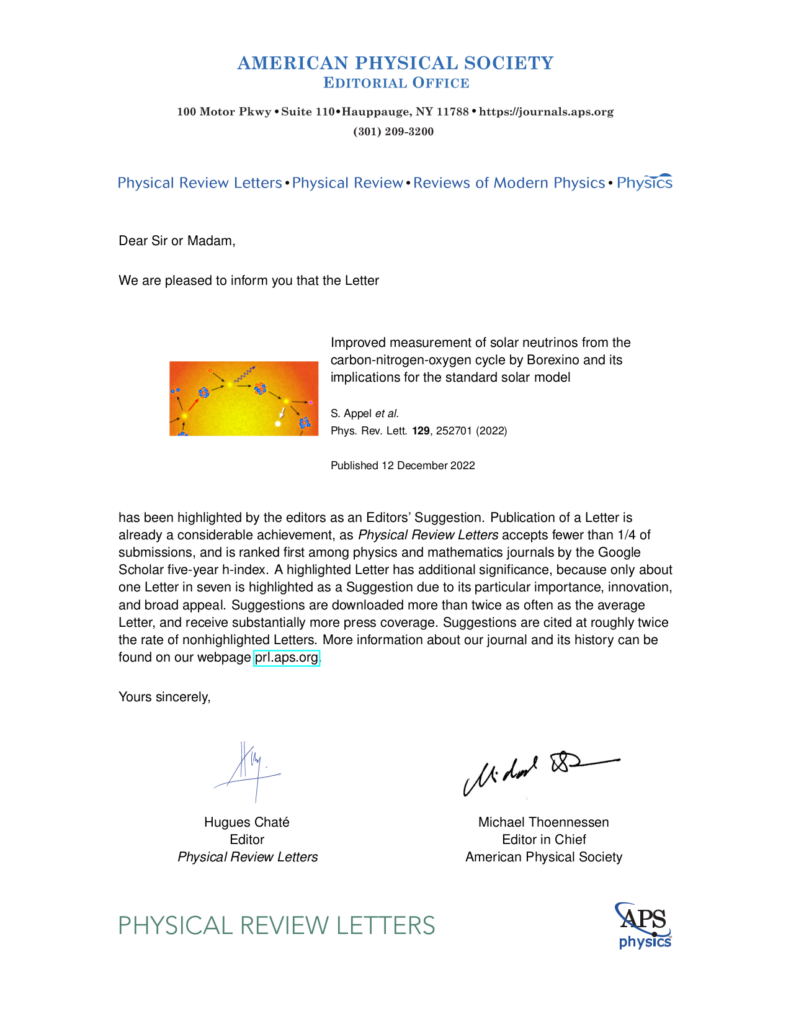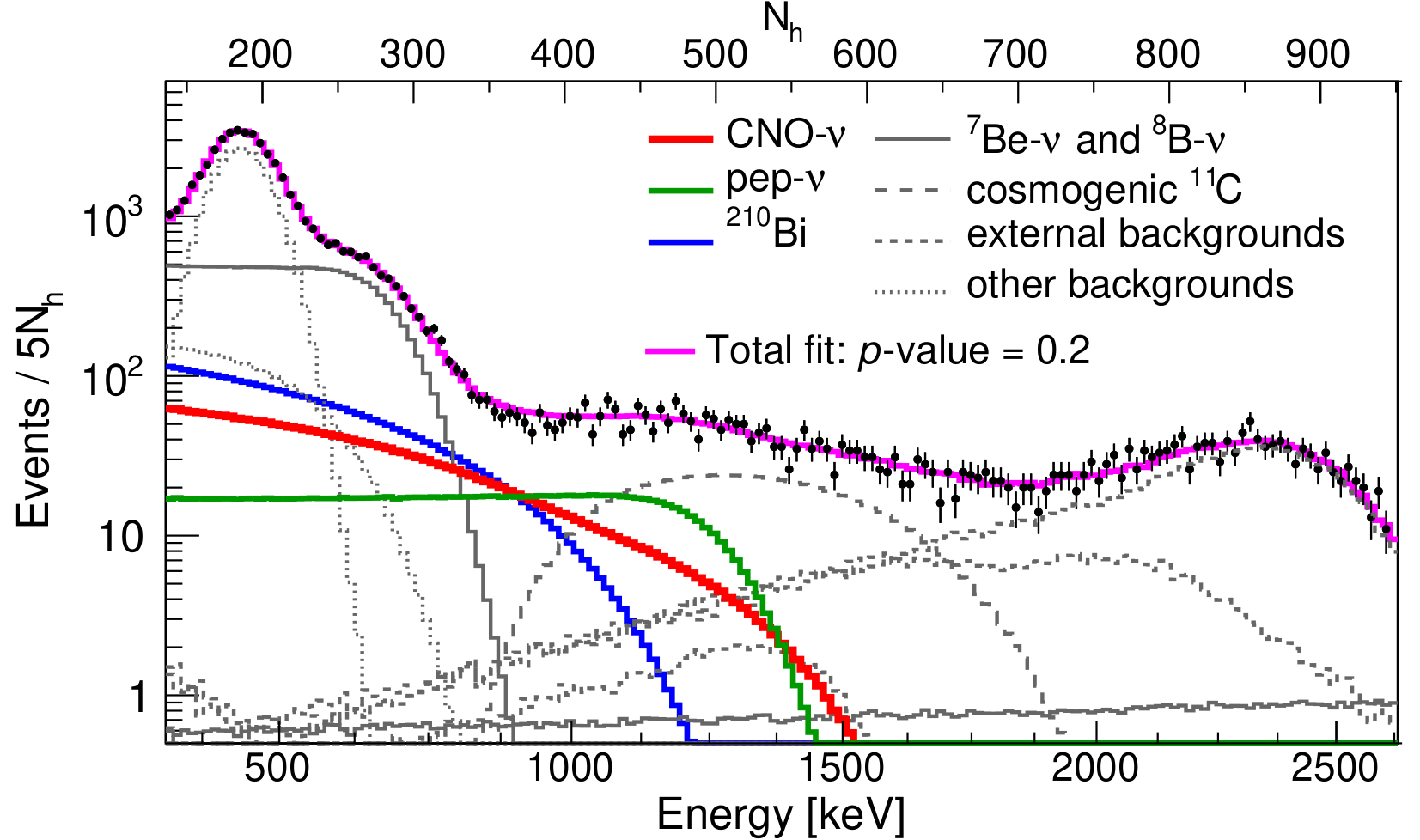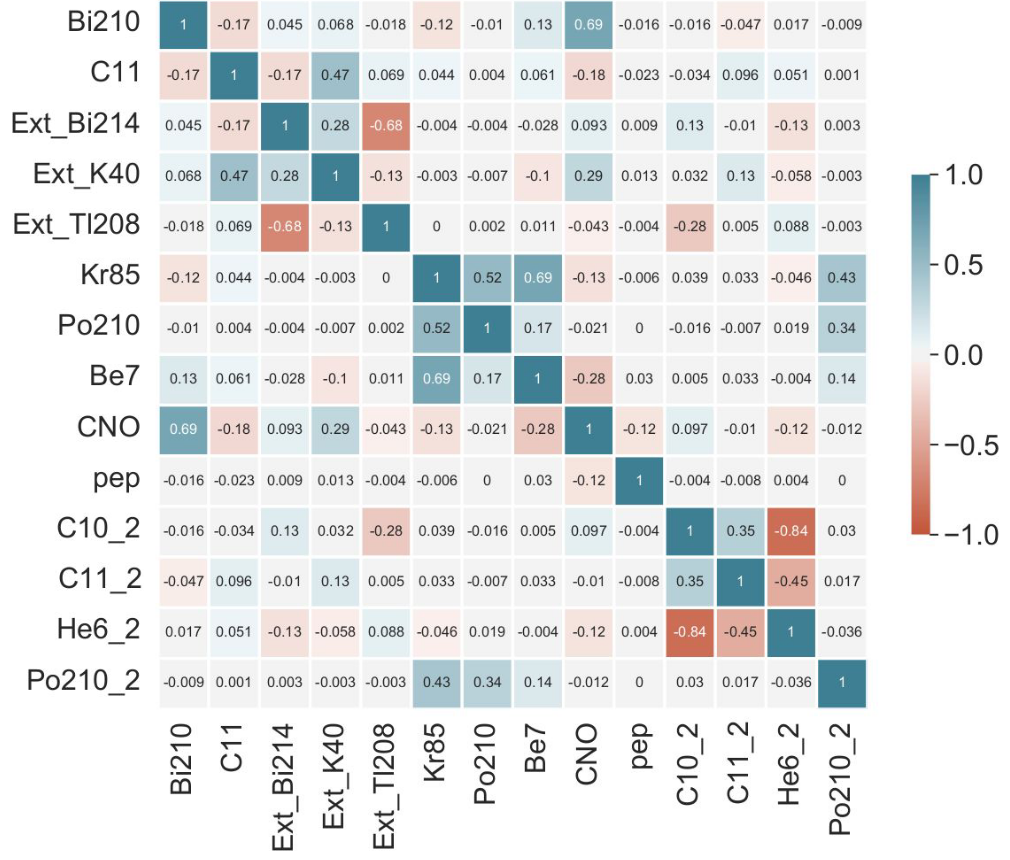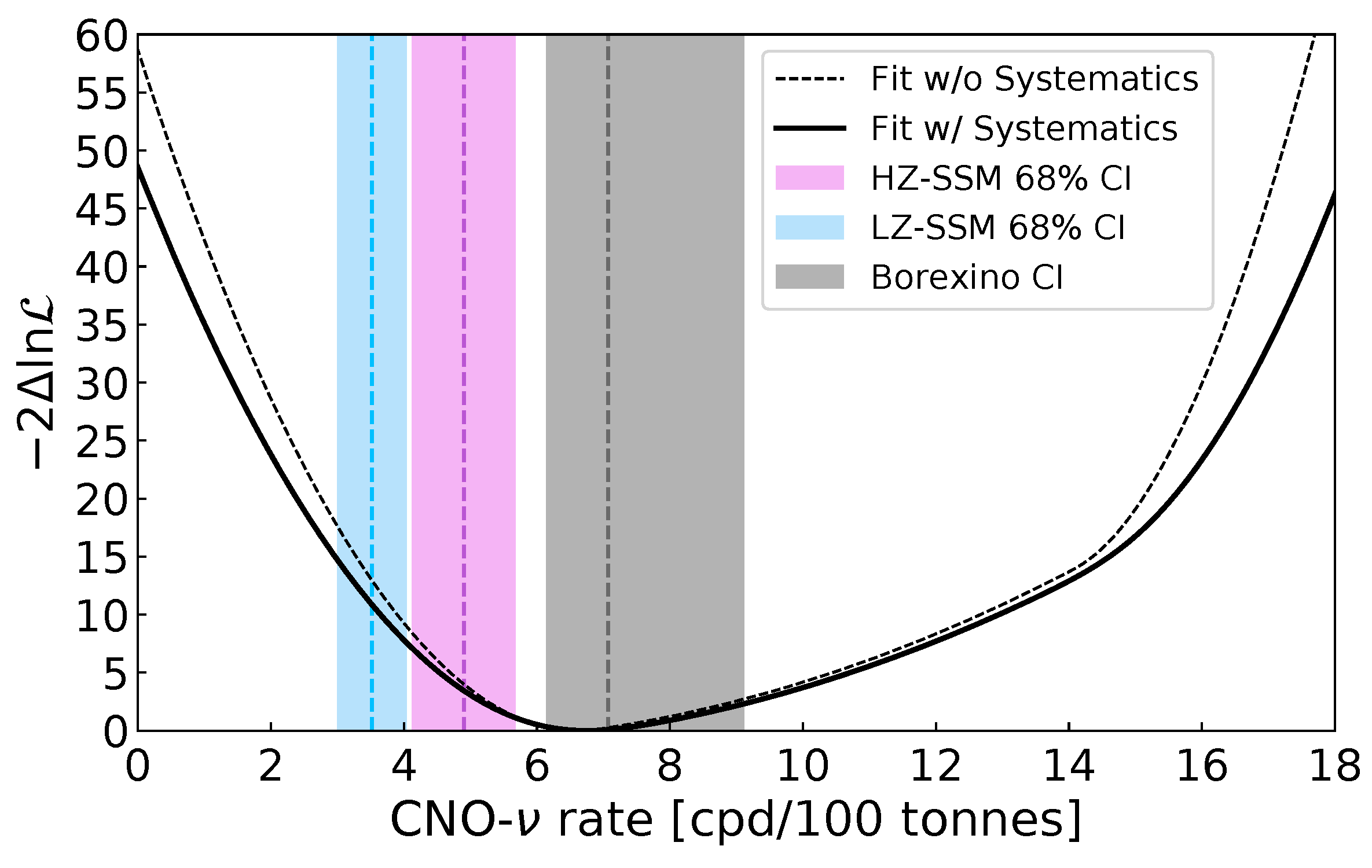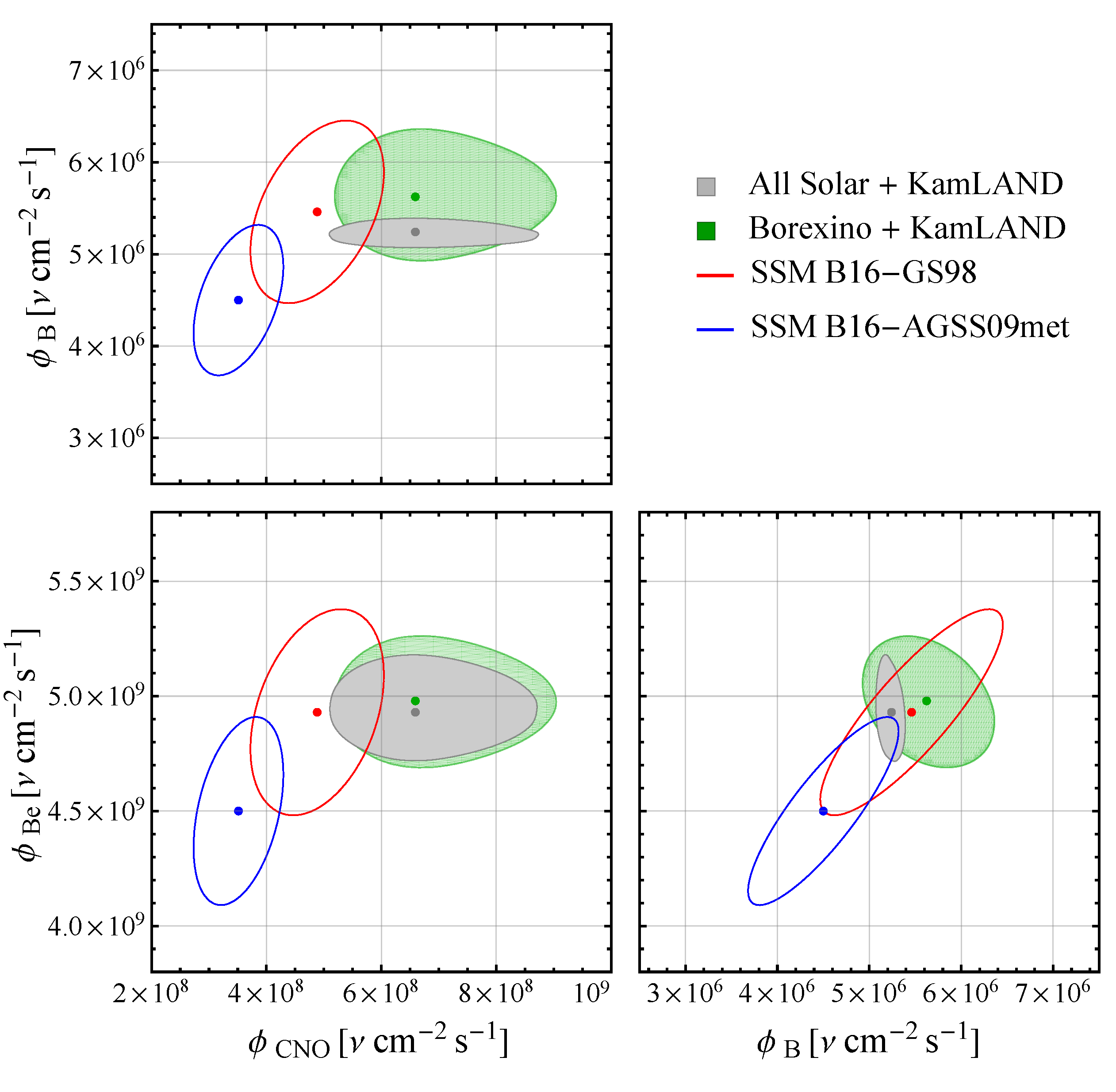Table of Contents Show
 Improved Measurement of Solar Neutrinos from the Carbon-Nitrogen-Oxygen Cycle by Borexino and Its Implications for the Standard Solar Model
Improved Measurement of Solar Neutrinos from the Carbon-Nitrogen-Oxygen Cycle by Borexino and Its Implications for the Standard Solar Model
Phys. Rev. Lett. 129, 252701 (2022) – Published 12 December 2022
[DOI:10.1103/PhysRevLett.129.252701]
This paper have been been highlighted. See Viewpoint:
“Elemental Accounting of the Solar Interior”.
Data availability
The datasets generated during the current study are freely available: see below (scroll down). Additional information is available from the Borexino Collaboration spokesperson (spokesperson-borex@lngs.infn.it) upon reasonable request.
Abstract
We present an improved measurement of the carbon-nitrogen-oxygen (CNO) solar neutrino interaction rate at Earth obtained with the complete Borexino Phase-III dataset. The measured rate, RCNO = 6.7 (-0.8 +2.0) counts/(day×100 tonnes), allows us to exclude the absence of the CNO signal with about 7σ C.L. The correspondent CNO neutrino flux is 6.6 (−0.9 +2.0) × 108 cm−2 s−1, taking into account the neutrino flavor conversion. We use the new CNO measurement to evaluate the C and N abundances in the Sun with respect to the H abundance for the first time with solar neutrinos. Our result of NCN = 5.78 (−1.00 +1.86) × 10−4 displays a ~2σ tension with the “low-metallicity” spectroscopic photospheric measurements. Furthermore, our result used together with the 7Be and 8B solar neutrino fluxes, also measured by Borexino, permits us to disfavor at 3.1σ C.L. the “low-metallicity” standard solar model B16-AGSS09met as an alternative to the “high-metallicity” standard solar model B16-GS98.
Open data
Figure 2a of our PRL publication reports the distribution of the Borexino data (events after selection cuts), and the spectral fit. The energy estimator ![]() represents the number of photoelectrons detected by photomultipliers, normalized to 2,000 live channels. For the sake of completeness, we also report the correspondent keV energy scale. Neutrino and background components are depicted over the Three Fold Coincidence (TFC) subtracted energy spectrum with suppressed
represents the number of photoelectrons detected by photomultipliers, normalized to 2,000 live channels. For the sake of completeness, we also report the correspondent keV energy scale. Neutrino and background components are depicted over the Three Fold Coincidence (TFC) subtracted energy spectrum with suppressed ![]() C background.
C background.
The distribution of the electron recoil energy scattered by solar neutrinos in the Borexino detector is defined by black points (properties of the data bins available here). CNO-neutrinos, ![]() Bi and pep-neutrinos are highlighted in solid red, blue and green, respectively, and all other components are in grey. The total spectral fit is depicted in magenta. The correlation matrix of this spectral fit is presented below and can be downloaded here.
Bi and pep-neutrinos are highlighted in solid red, blue and green, respectively, and all other components are in grey. The total spectral fit is depicted in magenta. The correlation matrix of this spectral fit is presented below and can be downloaded here.
Figure 2b of our PRL publication shows the CNO-neutrino rate negative log-likelihood (![]() ) profile obtained directly from the multivariate fit (dashed black line) and after folding in the systematic uncertainties (black solid line, profile available here). The cyan, violet and grey vertical bands show the 68% confidence intervals (CI) for the SSM-LZ (3.52
) profile obtained directly from the multivariate fit (dashed black line) and after folding in the systematic uncertainties (black solid line, profile available here). The cyan, violet and grey vertical bands show the 68% confidence intervals (CI) for the SSM-LZ (3.52 ![]() 0.52 cpd/100 tonnes) and SSM-HZ (4.92
0.52 cpd/100 tonnes) and SSM-HZ (4.92 ![]() 0.78 cpd/100 tonnes) predictions (according to N. Vinyoles et al. (2017), M. Agostini et al. (2020)) and the current Borexino result (corresponding to the black solid-line loglikelihood profile), respectively.
0.78 cpd/100 tonnes) predictions (according to N. Vinyoles et al. (2017), M. Agostini et al. (2020)) and the current Borexino result (corresponding to the black solid-line loglikelihood profile), respectively.
The following plot (Fig. 4 of the Borexino PRL publication) compares the Borexino + KamLAND experimental results (green area) with the theoretical predictions from the low metallicity (SSM B16-AGSS09met, blue) and high metallicity (SSM B16-GS98, red) Standard Solar Models in the ![]() (
(![]() B)-
B)-![]() (
(![]() Be),
Be), ![]() (
(![]() B)-
B)-![]() (CNO), and
(CNO), and ![]() (
(![]() Be)-
Be)-![]() (CNO) planes. The allowed contour obtained by combining the Borexino + KamLAND results with all solar data, and leaving free the oscillation parameters
(CNO) planes. The allowed contour obtained by combining the Borexino + KamLAND results with all solar data, and leaving free the oscillation parameters ![]() and
and ![]() , is also shown in grey. All contours correspond to 68.27% C.L.
, is also shown in grey. All contours correspond to 68.27% C.L.
The contours describing the Borexino measurements and the SSM-HZ (SSM-LZ) expectations are obtained taking into account the specific ![]() (
(![]() Be),
Be), ![]() (
(![]() B), and
B), and ![]() (CNO) evaluations (best fit values and related uncertainties) as well as their correlations, if any.
(CNO) evaluations (best fit values and related uncertainties) as well as their correlations, if any.
Best fit values are available here while the global analysis ![]() profiles can be download at the following links:
profiles can be download at the following links:
